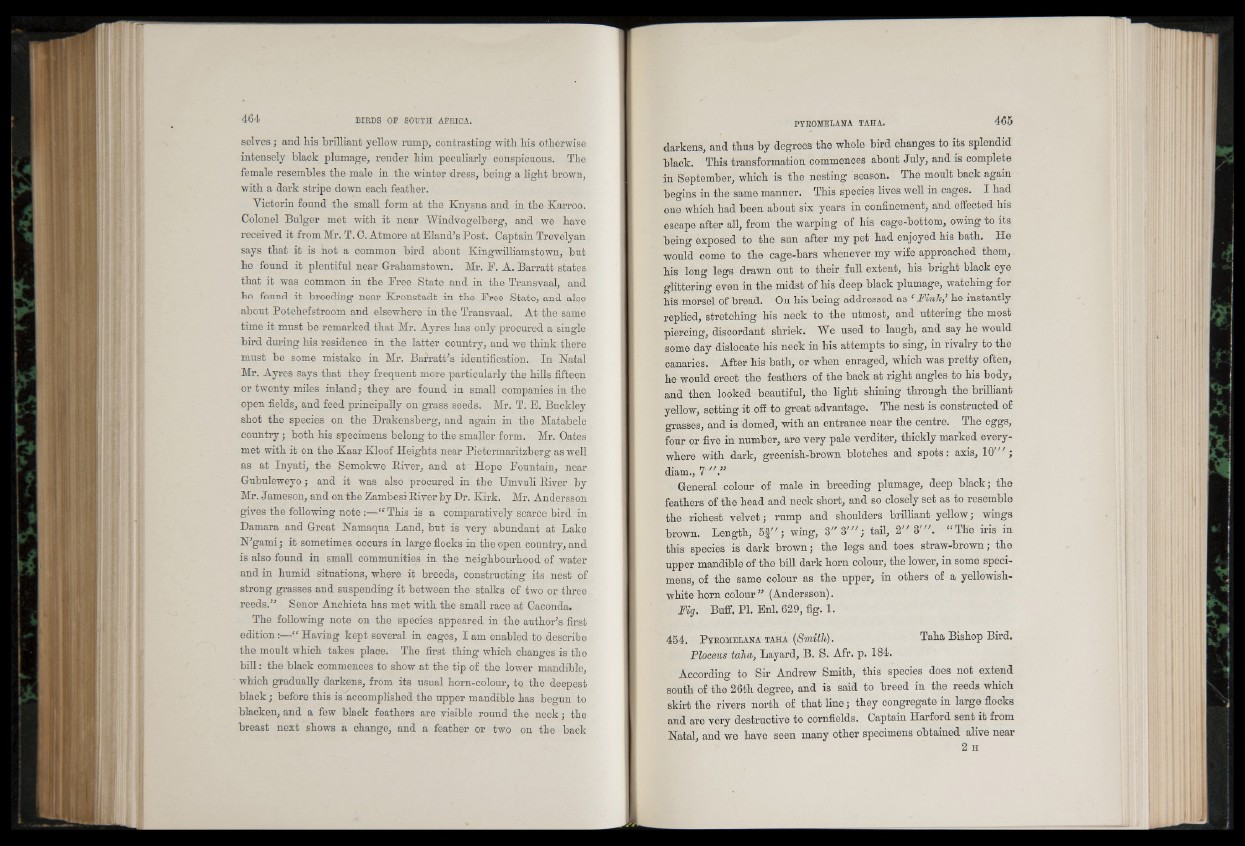
selves; and his brilliant yellow rump, contrasting with his otherwise
intensely black plumage, render him peculiarly conspicuous. The
female resembles the male in the winter dress, being a light brown,
with a dark stripe down each feather.
Victoria found the small form at the Knysna and in the Karroo.
Colonel Bulger met with it near Windvogelberg, and we have
received it from Mr. T. 0. Atmore at Bland’s Post. Captain Trevelyan
says that it is not a common bird about Kingwilliamstown, but
he found it plentiful near Grahamstown. Mr. P. A. Barratt states
that it was common in the Free State and in the Transvaal, and
he found it breeding near Kronstadt in the Free State, and also
about Potchefstroom and elsewhere in the Transvaal. At the same
time it must be remarked that Mr. Ayres has only procured a single
bird during his residence in the latter country, and we think there
must be some mistake in Mr. Barratt’s identification. In Natal
Mr. Ayres says that they frequent more particularly the hills fifteen
or twenty miles inland; they are found in small companies in the
open fields, and feed principally on grass seeds. Mr. T. E. Buckley
shot the species on the Drakensberg, and again in the Matabele
country; both his specimens belong to the smaller form. Mr. Oates
met with it on the Kaar Kloof Heights near Pietermaritzberg as well
as at Inyati, the Semokwe River, and at Hope Fountain, near
Gubuleweyo; and it was also procured in the Umvuli River by
Mr. Jameson, and on the Zambesi River by Dr. Kirk. Mr. Andersson
gives the following note :—“ This is a comparatively scarce bird in
Damara and Great Namaqua Land, but is very abundant at Lake
N’gami; it sometimes occurs in large flocks in the open country, and
is also found in small communities in the neighbourhood of water
and in humid situations, where it breeds, constructing its nest of
strong grasses and suspending it between the stalks of two or three
reeds.” Senor Anchieta has met with the small race at Caconda.
The following note on the species appeared in the author’s first
edition :—“ Having kept several in cages, I am enabled to describe
the moult which takes place. The first thing which changes is the
bill: the black commences to show at the tip of the lower mandible,
which gradually darkens, from its usual horn-colour, tq the deepest
black; before this is accomplished the upper mandible has begun to
blacken, and a few black feathers are visible round the neck; the
breast next shows a change, and a feather or two on the back
darkens, and thus by degrees the whole bird changes to its splendid
black. This transformation commences about July, and is complete
in September, which is the nesting season. The moult back again
begins in the same manner. This species lives well in cages. I had
one which had been about six years in confinement, and effected his
escape after all, from the warping of his cage-bottom, owing to its
being exposed to the sun after my pet had enjoyed his bath. He
would come to the cage-bars whenever my wife approached them,
his long legs drawn out to their full extent, his bright black eye
glittering even in the midst of his deep black plumage, watching for
his morsel of bread. On his being addressed as ‘ Finlc, he instantly
replied, stretching his neck to the utmost, and uttering the most
piercing, discordant shriek. We used to laugh, and say he would
some day dislocate his neck in his attempts to sing, in rivalry to the
canaries. After his bath, or when enraged, which was pretty often,
he would erect the feathers of the back at right angles to his body,
and then looked beautiful, the light shining through the brilliant
yellow, setting it off to great advantage. The nest is constructed of
grasses, and is domed, with an entrance near the centre. The eggs,
four or five in number, are very pale verditer, thickly marked everywhere
with dark, greenish-brown blotches and spots: axis, 10 " ;
diam., 7 //.”
General colour of male in breeding plumage, deep black; the
feathers of the head and neck short, and so closely set as to resemble
the richest velvet; rump and shoulders brilliant yellow; wings
brown. Length, 5 f " ; wing, 3" 3 '" ; tail, 2" 3 '". “ The iris in
this species is dark brown; the legs and toes straw-brown; the
upper mandible of the bill dark horn colour, the lower, in some specimens,
of the same colour as the upper, in others of a yellowish-
white horn colour ” (Andersson).
Fig. Buff. PI. Enl. 629, fig. 1.
454. Pykomelana taha (Smith). Taha Bishop Bird.
Ploceus taha, Layard, B. S. Afr. p. 184.
According to Sir Andrew Smith, this species does not extend
south of the 26th degree, and is said to breed in the reeds which
skirt the rivers north of that line; they congregate in large flocks
and are very destructive to cornfields. Captain Harford sent it from
Natal, and we have seen many other specimens obtained alive near
2 H